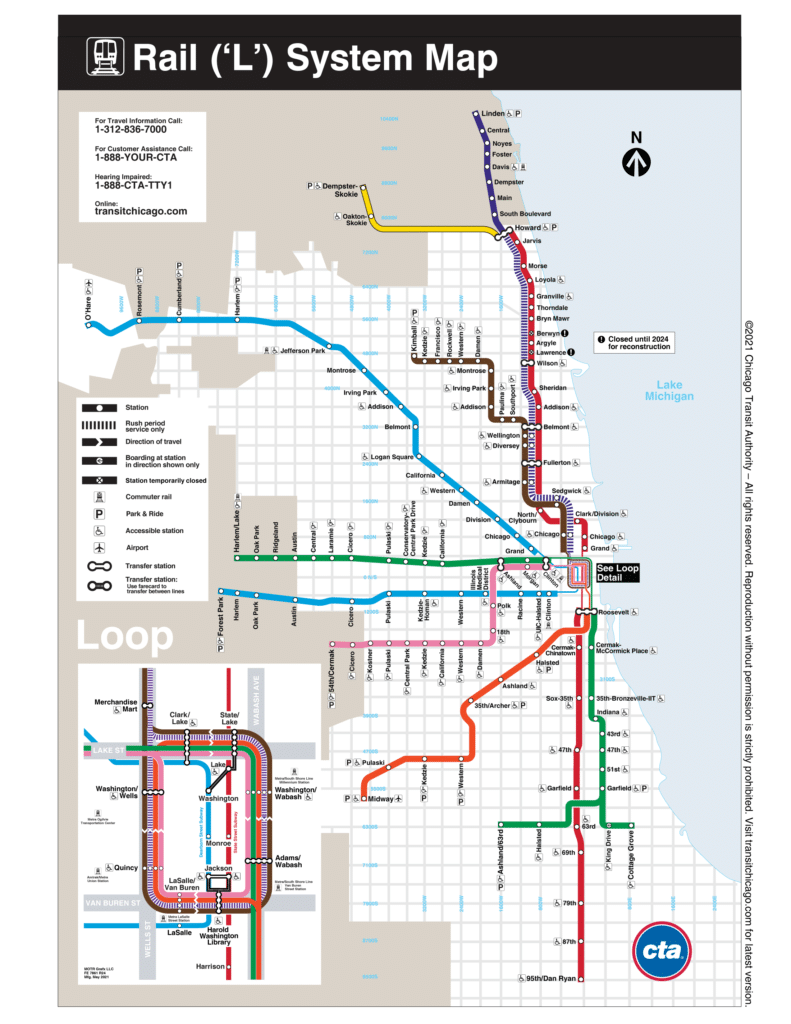Several modes of public transit, including the ‘L’ train, buses, the Metra commuter rail, and the Chicago Water Taxi, are available in Chicago. In the city, the “L” train is the most well-liked mode of public transportation thanks to its extensive network of routes, 145 stations, and certain lines’ 24-hour service. With routes that go both inside the city and to the outskirts, the bus system offers a more specialized kind of transportation. With 11 lines and 241 stations, the Metra commuter train provides a convenient method to get through the Chicago metropolitan area.
Metro system in Chicago – Basic information
Chicago’s Metro system is a quick and effective way to get about the city. With eight lines and 102.8 miles of track, it covers 145 stations. Red, Blue, Brown, Green, Orange, Pink, Purple, and Yellow lines can be seen. The lines are open Monday through Sunday from 5 am until 1 midnight. A one-day pass costs $10 while a single ride costs $2.50. The Chicago Metro system also provides a range of passes and specials for regular users, including the 7-Day Pass, 30-Day Pass, and Student Pass. The system offers numerous useful traveler services, including station maps, route planners, and real-time arrival information, and is also handicapped accessible.
The lines of the Chicago subway system
The metro lines in Chicago make it simple and stress-free to go around the city. To get commuters from the city center to the nearby suburbs, the Chicago Transit Authority (CTA) runs a total of eight lines.
RED LINE
The most popular line on the Chicago Metro system is the Red Line, which travels from the 95th/Dan Ryan Station in the south to the Howard Station in the north. It makes stops at well-known landmarks like Wrigley Field, the Magnificent Mile, and the Chicago River, among others. The Red Line also provides direct service to both the O’Hare International Airport and the Midway International Airport.
Blue line
The O’Hare International Airport in the northwest is connected to the Forest Park neighborhood in the southwest by the Blue Line. It stops at a number of locations, including the United Center, Navy Pier, and the Chicago Art Institute, among other places. In addition to this, the Blue Line provides passengers with unobstructed passage to the Amtrak and Metra rail networks.
Brown line
The Brown Line travels all the way from Kimball Station in the north-west to the Loop in the south-central part of the city. Along the journey, it makes stops at well-known destinations such as Lincoln Park Zoo, Millennium Park, and the Museum of Science and Industry.
Green line
The Green Line travels all the way from the northernmost Harlem/Lake Station all the way down to the southernmost Ashland/63rd Station. This route makes stops at a number of well-known locations, including the University of Chicago, the University of Illinois at Chicago, and the Field Museum of Natural History, to name just a few of them.
Orange line
The Orange Line is able to run all the way from the Midway International Airport in the south-west to the Loop in the north. This route makes stops at a number of Chicago’s most popular attractions, including the Museum of Science and Industry, the Art Institute of Chicago, and the Chicago Botanic Garden, to name just a few.
Yellow line
The Yellow Line travels all the way from the Skokie Station in the far north to the Howard Station in the far south. The Shedd Aquarium, the Chicago History Museum, and the Museum of Contemporary Art are three of the most popular attractions in the city that are accessible via this line.
Pink line
The Pink Line is one that travels all the way from the 54th/Cermak Station in the west to the Loop in the east. This line makes stops at a variety of sites, some of which are the Garfield Park Conservatory, the Illinois Medical District, and the United Center, amongst others.
Purple line
The Purple Line travels from the Linden Station in the north all the way down to the Linden Station in the south. This route provides service to a number of well-known destinations, including as the Museum of Contemporary Art, the Willis Tower, and the Field Museum of Natural History.
Map of Chicago Metro 2023 – Free Download in PDF

Click and download the map of Chicago’s underground system for 2023
Anyone navigating the Windy City will find the Chicago Metro Map 2023 to be a handy tool. A thorough map of the entire metro region, including the downtown area, O’Hare International Airport, and nearby suburbs, is available as a free PDF download. It makes it simple to plan routes, finds sights, and locate public transit, making it ideal for tourists, business travelers, and locals alike. The Chicago Metro Map 2023 is a must-have for anyone wishing to discover the City of Big Shoulders because of its straightforward layout and precise information.
Public transport tickets in Chicago – Best types for travelers & actual prices
There are many ways to move around the Windy City, including buses, railroads, and water taxis. But it can be difficult to decide which ticket type is best for you with so many options available. Let’s examine the various ticket categories and costs offered in Chicago.
Chicago’s all-in-one fare card is called the Ventra card. It is available for purchase at any Ventra vending machine and works with both Pace and the CTA (Chicago Transit Authority) buses. A one-day pass costs $10, a three-day pass costs $20, and a seven-day pass costs $28. These cards entitle you to unlimited trips on the CTA and Pace buses as well as reduced rates on the Metra commuter rail service and the Divvy bike share program in Chicago.
A single-ride ticket is available for $3 if you’re seeking a quicker or more flexible option. The two-hour single-trip ticket is valid for usage on both CTA and Pace buses. A transfer ticket is also available for $3. You can use this ticket on CTA and Pace buses, and it entitles you to one transfer within two hours of your first travel.
Additionally, Metra train tickets are available. The cost of one-way tickets varies according to the route and distance covered. You can purchase a one-ride, ten-ride, or monthly pass. Last but not least, you can buy water taxi tickets. Depending on the route and the time of day, tickets might cost anywhere from $3 to $7.
The 3-day Ventra card is the best choice for visitors to Chicago who will be staying for three days. This card grants unlimited travel on the CTA and Pace buses in addition to discounts on Metra and Divvy. It is the city’s most economical mode of transportation.
So be sure to look at the many ticket possibilities if you’re considering a trip to Chicago. You won’t have to spend a fortune exploring the city if you have the correct kind of ticket.
Summary of fares for public transport in Chicago
- Single-ride tickets cost $3, two-hour single-trip tickets are good for use on both CTA and Pace buses, and transfer tickets are also available for $3.
- Ventra cards may be purchased at any Ventra vending machine and operate with both Pace and CTA buses.
- The best option for visitors visiting Chicago is the 3-day Ventra card, which offers unlimited travel on CTA and Pace buses as well as discounts on Metra and Divvy.
- Water taxi fares range from $3 to $7 depending on the route and time of day.
Timetables & Schedules of the Chicago Metro System
The schedule for the Chicago Metro system is consistent but changes according to the time of day. The Metro operates at a faster frequency of every 10–12 minutes during off-peak hours and every 5–6 minutes during rush hour. The Chicago Metro runs every 15-20 minutes on weekends, which is a somewhat shortened timetable. There are special holiday schedules that are released beforehand for specific days throughout the year in addition to the usual timetable.
What Are Other Options For Public Transportation In Chicago?
In addition to the metro, Chicago residents have a variety of alternative public transit options. There are many ways to move around the city, including buses, trains, and paratransit, all provided by the Chicago Transit Authority (CTA). Riders can use the CTA website to locate the most efficient route for their travel since there are bus lines available around the city. Eight rail lines, which are a terrific way to get around the city fast and are also run by the CTA, are also available. The CTA offers paratransit services for people with impairments, which offer door-to-door transportation. Metra commuter rail, which runs 11 lines throughout the Chicago metropolitan area, and the bike-sharing service Divvy are additional options for public transit in Chicago. Chicagoans can easily travel to the city without relying on the metro because to the abundance of transportation options.
how does the public bus transportation work in Chicago
The enormous public transit network in Chicago is dependable and practical for commuters. The primary supplier of public bus transportation is the Chicago Transit Authority (CTA), which operates more than 1,800 buses throughout the metro area.
A wide range of services and routes are available across the city on CTA buses. All passengers, including those with disabilities, have access to the buses. They offer frequent service to popular locations, with the busiest lines operating around-the-clock. A destination board is located on each bus and displays the route number and the name of the last stop. Additionally, every bus has a fare box where passengers can purchase tickets using cash or a transit card.
The #66, #50, and #49 buses are the three bus routes that are utilized the most frequently in Chicago. Between Chicago’s Lakeview neighborhood and the Loop, the #66 bus travels often. From the South Side to the Loop, use the #50 bus, and from the West Side to the Loop, take the #49 bus.
For commuters’ convenience, the CTA also provides extra services such fast buses, night buses, and rush hour buses. Express buses travel on key routes during peak hours and stop at fewer locations than normal buses. The Owl service, also known as the night bus service, runs from midnight to five in the morning. Buses that run during the morning and afternoon rush hours stop at a lot of well-known places.
How do the public TRAINS work in Chicago
Chicago has a robust and dependable public transit system, with trains being one of the most used modes of transportation in the city. The city has been served by a network of railroads since the 1850s, making it simple for residents and guests to travel around.
The South Shore Line, which connects the city to South Bend, Indiana, and the Metra commuter rail lines, which run from Chicago to the suburbs, are the two most well-known railway connections to other surrounding cities. Additionally, there is an Amtrak route that runs to and from Chicago’s Union Station. A Ventra Card, which is accessible at any CTA station, must be purchased before boarding a train in Chicago. This card can be used to transfer between the city’s bus system and to purchase railway tickets.
Chicago also boasts a number of privately owned and run rail companies in addition to the CTA, such as the Chicago and North Western Transportation Company and the Chicago South Shore and South Bend Railroad. These businesses provide transportation to numerous locations across the city as well as to other cities throughout the state.
How To Get From Chicago O’Hare International Airport (oRD) To The City Center With Public Transport?
For first-time tourists, getting from Chicago O’Hare International Airport to the city center can be a difficult process because getting through the city frequently necessitates knowledge of public transit routes and options. Fortunately, you don’t need to take a taxi to go from the airport to the city center because there are a number of public transit choices available.
Taking the CTA Blue Line ‘L’ Train is the easiest and quickest way to get from O’Hare International Airport to the city center. The Blue Line provides service to the city center around-the-clock and makes stations at both small and significant downtown areas, including the Magnificent Mile and the Chicago Loop. Tickets can be purchased from the vending machines nearby the station or using the Ventra app, and the Blue Line station is situated on the ground floor of O’Hare International Airport. To get to downtown Chicago, it takes around 45 minutes and costs $5.
The Pace Bus Route 250 provides transportation from O’Hare International Airport to the city center for individuals who would rather use a bus. Every 30 minutes, the Route 250 bus travels from the airport to downtown Chicago. It departs from the lower level of the terminal. Tickets cost $2 and can be bought right from the bus driver. The journey to downtown Chicago takes about 1 hour and 15 minutes.
The GO Airport Express shuttle is a final option for those who want to go into the city. The GO Airport Express shuttle serves multiple drop-off locations across downtown Chicago, including the Chicago Loop, the Magnificent Mile, and Michigan Avenue. It departs from the lower level of O’Hare International Airport. Tickets for the shuttle, which runs every 30 minutes, can be purchased at the lower-level GO Airport Express kiosk or online. The trip to downtown Chicago costs $30 and takes about an hour.
From O’Hare International Airport to the city center, there are a number of public transit alternatives. The Pace Bus Route 250 and the GO Airport Express shuttle are two alternate routes, however the CTA Blue Line ‘L’ Train is the most practical and quick means to get from the airport to the city center. Whichever choice you select, you can be confident that you will reach your destination quickly and affordably.
how to spend 3 days in Chicago?
You’re in for an incredible experience if this is your first time visiting Chicago! You’ll have plenty of time to discover this dynamic city in all its splendor with three days to explore. Here is a guide to help you make the most of your three days in Chicago if you’re seeking a special experience, fantastic restaurants recommended by locals, and fun nightlife.
Day One: Special Occasions
Get a close-up look at the city’s architecture to start the day. Join the Chicago Architecture Foundation river cruise to explore the city’s iconic structures and their origins as you float along the Chicago River. After that, visit the Field Museum to learn about the local natural history and browse the numerous eye-catching exhibitions. Take in the city lights as you wander around the Magnificent Mile at night to cap off the day.
Day 2: Neighborhood Restaurants
Without trying some of the regional cuisines, no vacation to Chicago would be complete. At Lou Malnati’s, try the traditional deep-dish pizza for breakfast. For lunch, grab a snack at Au Cheval, a popular burger restaurant, in the hip West Loop district. Visit the city’s award-winning restaurant Girl & the Goat for dinner if you want to experience international cuisine with a unique touch. Do you want to sample some superb seafood? Visit Shaw’s Crab House for a feast of succulent fresh fish.
Day Three: A Night of Fun
The city comes to life at night. Go to Wrigleyville, the Chicago Cubs home field, to hear some live music. There are many bars and clubs in this area where you may hear jazz, blues, and rock music. Visit the Green Mill Jazz Club in the Lincoln Park neighborhood for a craft beer if you prefer a more laid-back setting. You can’t go wrong with River North’s nightlife scene for a crazy evening. You can explore a variety of bars, clubs, and lounges in this area.
Whatever you choose to do in Chicago, it will undoubtedly be an unforgettable experience. You’ll definitely make the most of your three days in this great city with a unique experience, fantastic local dining options, and fun nightlife.
What other metro systems are nearby to Chicago?
Less than 400 miles separate Chicago from the Twin Cities of Minneapolis and Saint Paul, Minnesota, whose Metro Transit metro system is among the best in the nation. It serves the majority of the area and is made up of light rail, buses, and commuter rail. Amtrak trains from Minneapolis can be used to reach Chicago. Milwaukee, Wisconsin, has a metro system as well, and it’s only a 90-minute drive from Chicago. The Milwaukee County Transit System (MCTS) connects to a number of suburbs and serves the larger Milwaukee area. Additionally, MCTS provides free bus transfers, making it a practical choice for commuters. Chicago may be reached by car from the Detroit metro region as well. In the city and its suburbs, the Detroit Department of Transportation (DDOT) is active. DDOT offers access to Canada through the Detroit-Windsor tunnel. The distance from Chicago to Indianapolis, Indiana, is only a few hours. The city’s public transportation company, IndyGo, has numerous commuter lines in addition to dozens of bus routes.
Summary of our tour guide for Chicago
Chicago, a thriving American metropolis in the Midwest, is well-known for its outstanding architecture and vibrant arts community. The third most populous city in the US, it is home to more than 2.7 million people. There are many options for public transportation in the city, including a robust bus network, the Chicago ‘L’ rapid transit system, and commuter train services that link the city to the nearby suburbs via Metra. The system is practical and effective, making it simple to travel throughout the city and take advantage of everything that it has to offer.
Top 5 FAQs and answers about Chicago public transport?
How do I utilize Chicago’s public transportation system?
- In Chicago, using public transportation is simple. The city’s bus and train systems are run by the Chicago Transit Authority (CTA). To use the CTA, you must buy a Ventra card. You may buy this card at any CTA station or online, and it enables you to pay for bus and train travels. After receiving your card, you can pick your route and buy your tickets.
Which Chicago public transportation choices are available?
- In the entire city, the CTA runs both bus and train services. The bus system, which covers the majority of the city, is the most used mode of transportation. The ‘L’ train system is a fantastic method to travel fast and effectively. It provides service to various areas as well as the city center.
How much does Chicago’s public transportation cost?
- Each trip on the CTA’s bus and train systems costs $2.50. You can pay with your Ventra card or buy tickets in advance. Consider buying a 7-day or 30-day pass, which allows unlimited rides for the term of the pass, if you intend to use public transportation frequently.
Are there any Chicago public transportation savings available?
- Yes, specific groups of people are eligible for discounts. Seniors and students are eligible for lower CTA service fees. Additionally, if you’re changing from one method of transportation to another, there are Ventra cards that enable you to pay a discounted fare.
Exist any further services in Chicago?
- Yes, Chicago does have a variety of alternative options available. These consist of bike-sharing, ride-sharing, and taxi services. Depending on your needs, all of these services are excellent options for getting around the city.
Useful links







